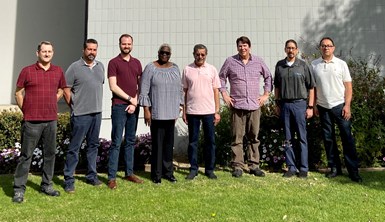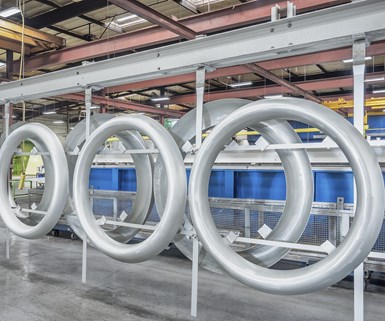Valence Surface Technologies-Lynwood Plant Ranks First in 2020 Electroplating Operations
Los Angeles-area facility gets top marks in this year’s Products Finishing North American benchmarking survey.
For a company that has never entered Products Finishing’s Top Shops Benchmarking Survey before, Valence Surface Technologies, in The Woodlands, Texas, did quite well for its first time. In California, its Garden Grove facility ranked in the Top 50 and its Lynwood facility was named the No. 1 Finishing Operation in North America for 2020. Not a bad start.

The management team at Valence’s Lynwood facility includes (left to right) Paul Sellers, customer service manager; Jose De Santiago, quoting and billing manager; Derek Ruhl, lab manager; Linda Sanders, planning supervisor; Ashok Advani, general manager; Steve Campeggi, finance manager; Jess Lozano, quality manager; and Jorge Ortiz, production manager.
Valence — which bills itself as the largest independent, fully integrated surface finishing company for the aviation, aerospace/communications and military/defense markets — maintains 12 facilities comprising 850,000 square feet/78,967 square meters of operating space, employs 1,300 people, serves 3,000 global customers, and processes over 1 million parts per month. The company was formed in 2013 by a team of aviation/defense industry pros that had worked in both machining/fabricating and surface/heat treating on both the OEM and supplier sides.

Valence maintains 12 facilities comprising 850,000 square feet of operating space and processes over 1 million parts per month.
“Our management team, which is still intact, knew the supply-chain pain points involved on both sides,” explains Chris Grapsas, Valence vice president of sales and marketing. “We saw a glaring need to have one organization with multiple locations in multiple regions that could help simplify the supply chain and offer more solutions post-machining than any single company at the time could.”
In an industry where the supply chain is notoriously fragmented and geographically spread out, necessitating significant resources to manage the high costs, long lead times and not insignificant inventory risks, Valence is an interesting anomaly and quite possibly indicative of where these market segments are headed. With facilities strategically located across the U.S. in all major aviation/defense/space regions, the company offers services ranging from nondestructive testing and shot peen to chemical processing (including anodizing, conversion coating, passivation and plating) and painting, as well as value-added subassembly and vendor-managed inventory.

Valence provides an all-inclusive surface-finishing solution to reduce costs, number of suppliers involved, distance parts must travel and lead times.
“Valence exists to improve the aerospace/defense supply chain,” Grapsas declares. “By providing an all-inclusive surface-finishing solution in key regions of the country, we reduce costs, the number of suppliers involved, the distance parts must travel and lead times, all while maintaining over 3,600 approvals for every prime and program in existence today. That positions us to handle high-value, mission-critical parts ranging from the smallest satellite components to the largest aerostructure assemblies.”
Valence-Lynwood provides a good example of the company’s extensive surface-finishing capabilities. “Our Lynwood plant, which was acquired by Valence in 2018, but has been in operation since 1957, has some of the largest chemical-processing tanks in industry,” notes Ashok Advani, Valence general manager-Lynwood facility.

Valence has three independent process lines in a single facility, with a massive one that’s 110 feet long [33.5 meters].
“We have three separate tank lines that are 26 feet [7.9 meters], 62 feet [18.3 meters] and 110 feet long [33.5 meters]. It’s unusual to have three independent process lines in a single facility, and especially to have one as massive as 110 feet. That gives us a pretty big advantage over other facilities — inside and outside the company — both in terms of the size part we can process and the number of parts we can process at one time. We also have seven paint booths and ovens. Among Valence facilities, we can process the largest parts or the largest quantities of parts at one time, and that helps us keep lead times to an industry-leading standard of 4-5 days.”
One of the hallmarks of Valence is how actively team members share knowledge to improve operations — both regionally and nationally. “We meet regularly to share best practices and look at ways to ‘lean out’ our manufacturing operations in order to shorten lead times and lower costs,” Grapsas adds. One example that has benefited the Lynwood facility in the last six months is the shift to digital masking.
“Rather than trying to work from PDF drawings you can barely read to hand-cut masking to size and place it on the part, we’re now using 3D CAD models to import masking attributes and cut them on our electronic cutters,” Advani explains. “This allows us to do much more complex jobs on such programs as the F-35 and new T-7A Red Hawk. We developed these new techniques and methods at Lynwood by learning from our other Valence locations that have perfected the process.”
Another measure of the capabilities of the Lynwood facility is the experience of its management team. Advani has spent 33 years at the company (with a 9-year stint at McDonnell Douglas — now the Boeing Co. — in between). The quality manager has 26 years at the company and the production manager has 46 years. “I’ve seen three different logos in my time here,” Advani laughs. “Given the breadth and depth of our team’s experience, we know we can rely on each other when there’s a tight deadline or a challenging project to complete. We have each other’s backs and we work well together.”
A major project that the Lynwood facility is implementing this year is installation of a wastewater treatment system on the chemical processing lines that will allow water to be clarified and reused. “Our tanks are so big that they take an entire day to refill,” Advani says. “Our 26-foot line holds 4,800 gallons [18,500 liters], our 62-foot line holds 6,400 gallons [24,700 liters] and our 110-foot line holds 48,000 gallons [185,700 liters].”
“Water is a precious resource — especially in California these days — and while this is a significant CAPEX [capital expenditure] for Valence, its environmental impact will be massive,” Grapsas says.
Related Content
Top Shop’s Journey to Building a Unique Brand
Since this new Ohio plater took over the space and assets of a former plating business, it is intentional about setting itself apart from prior ownership.
Read MoreProducts Finishing Reveals 2024 Qualifying Top Shops
PF reveals the qualifying shops in its annual Top Shops Benchmarking Survey — a program designed to offer shops insights into their overall performance in the industry.
Read MoreHow to Build a Powder Coating Brand
Maui Powder Works, a 2022 Products Finishing Top Shop, shares the story behind how it grew from an island job shop to a recognized voice in the finishing community.
Read MoreHighlights from SUR/FIN 2023
Products Finishing offers a recap of some of the topics that were top of mind at the SUR/FIN 2023 finishing industry trade show.
Read MoreRead Next
Episode 45: An Interview with Chandler Mancuso, MacDermid Envio Solutions
Chandler Mancuso, technical director with MacDermid Envio discusses updating your wastewater treatment system and implementing materials recycling solutions to increase efficiencies, control costs and reduce environmental impact.
Read MoreEducation Bringing Cleaning to Machining
Debuting new speakers and cleaning technology content during this half-day workshop co-located with IMTS 2024.
Read MoreDelivering Increased Benefits to Greenhouse Films
Baystar's Borstar technology is helping customers deliver better, more reliable production methods to greenhouse agriculture.
Read More
.jpg;width=70;height=70;mode=crop)





















